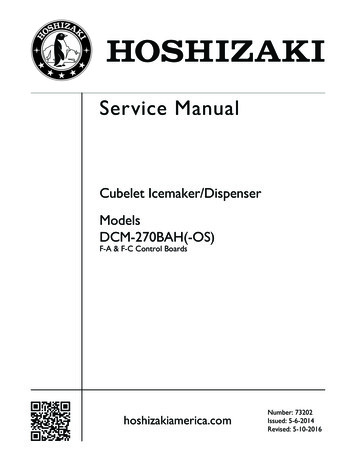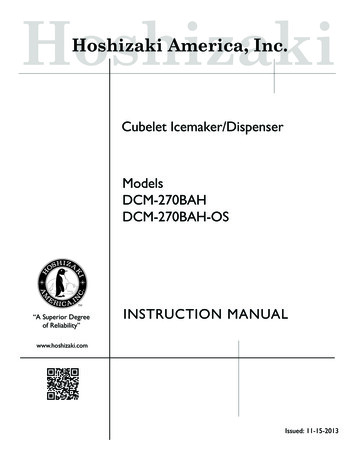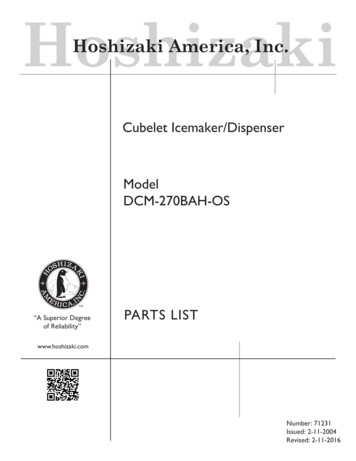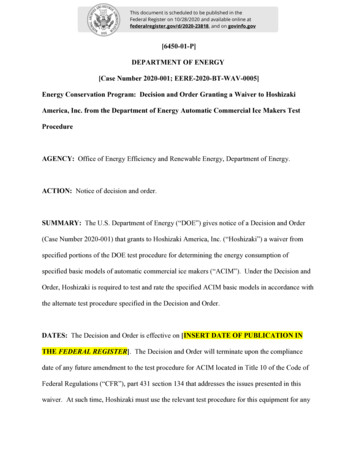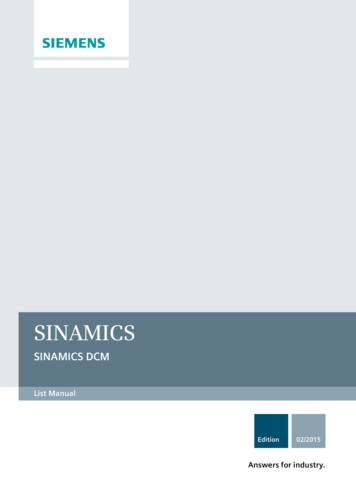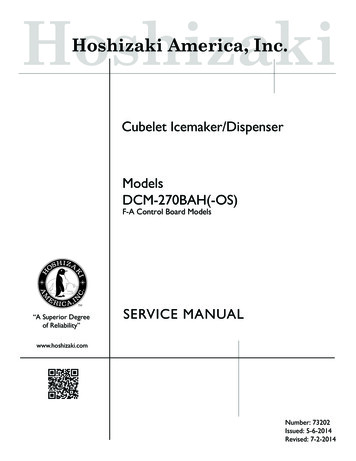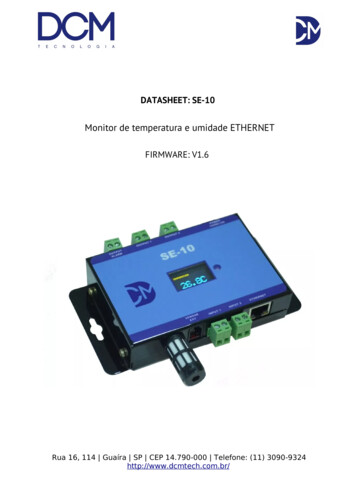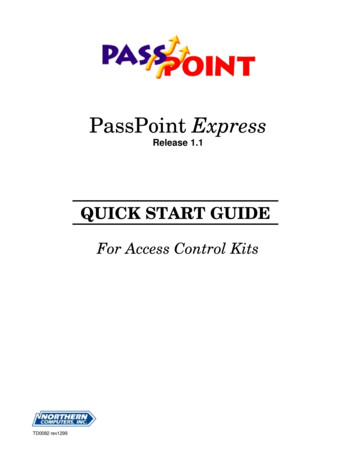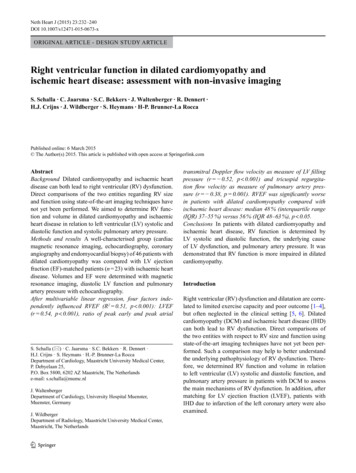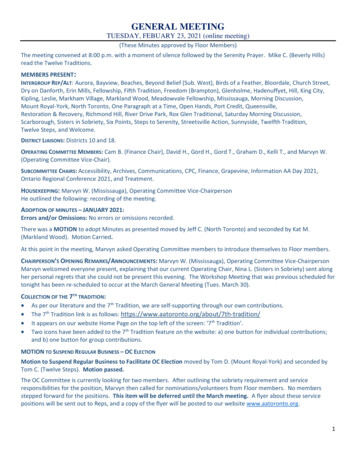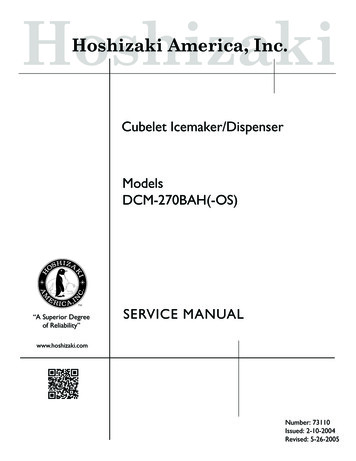
Transcription
HoshizakiHoshizaki America, Inc.Cubelet Icemaker/DispenserModelsDCM-270BAH(-OS)“A Superior Degreeof Reliability”SERVICE MANUALwww.hoshizaki.comNumber: 73110Issued: 2-10-2004Revised: 5-26-2005
IMPORTANTOnly qualified service technicians should attempt to service or maintain this icedispenser. No service or maintenance should be undertaken until the technicianhas thoroughly read this service manual.HOSHIZAKI provides this manual primarily to assist qualified service technicians in theservice and maintenance of the dispenser.Should the reader have any questions or concerns which have not been satisfactorilyaddressed, please call or write to the HOSHIZAKI Technical Support Department forassistance.HOSHIZAKI provides this manual primarily to assist qualified service technicians in theservice and maintenance of the dispenser.Should the reader have any questions or concerns which have not been satisfactorily addressed, please call or write to the HOSHIZAKI Technical Support Department forassistance.HOSHIZAKI AMERICA, INC.618 Highway 74 SouthPeachtree City, GA 30269Attn: HOSHIZAKI Technical Support DepartmentPhone: 1-800-233-1940 Technical Service(770) 487-2331Fax:(770) 487-3360Web Site: www.hoshizakiamerica.comNOTE:To expedite assistance, all correspondence/communication MUST include thefollowing information: Model Number Serial Number Complete and detailed explanation of the problem2
Please review this manual. It should be read carefully before the ice dispenser is servicedor maintenance operations performed. Only qualified service technicians should serviceand maintain the dispenser. This manual should be made available to the technician prior toservice or maintenance.CONTENTSI. Specifications . 41. DCM-270BAH-OS (air-cooled) . 4II. General Information . 51. Construction . 52.Operation - How it works . 6III. Technical Information . 71. Water Circuit and Refrigerant Circuit. 72. Performance Data . 8[a] DCM-270BAH-OS (air-cooled) . 83. Wiring Diagram . 94. Sequence of Electrical Circuit . 10IV. Service Diagnosis . 201. No Ice Production . 202. Low Ice Production . 223. Faulty Dispenser. 23[a] Optical Sensor Description . 234. Other . 25V. Removal and Replacement of Components . 261. Service for Refrigerant Lines . 26[a] Refrigerant Recovery. 26[b] Evacuation and Recharge [R-404A] . 262. Brazing . 273. Removal and Replacement of Compressor . 284. Removal and Replacement of Drier . 295. Removal and Replacement of Thermostatic Expansion Valve . 306. Removal and Replacement of Pressure Switch . 317. Removal and Replacement of Control Water Valve . 328. Removal and Replacement of Flush Water Valve . 339. Removal and Replacement of Float Switch. 3410. Removal and Replacement of Bin Control Switch Assembly . 3511. Removal and Replacement of Storage Bin Assembly . 3612. Removal and Replacement of Agitator and Drip Ring . 3713. Removal and Replacement of Evaporator Assembly . 38VI. Cleaning and Maintenance Instructions . 411. Preparing the Ice Dispenser for Long Storage . 412. Cleaning Instructions . 42[a] Cleaning Procedure . 42[b] Sanitizing Procedure . 452. Maintenance Instructions . 463
I. Specifications1. DCM-270BAH-OS (air-cooled)AC SUPPLY VOLTAGEAMPERAGEMAXIMUM FUSE SIZEMINIMUM CIRCUIT AMPACITYAPPROXIMATE ICE PRODUCTIONPER 24 HR.lbs./day ( kg/day )Reference without *marksSHAPE OF ICEICE QUALITYAPPROXIMATE STORAGE CAPACITYELECTRIC & WATER CONSUMPTIONELECTRIC W (kWH/100 lbs.)POTABLE WATERgal./24HR (gal./100 lbs.)EXTERIOR DIMENSIONS (WxDxH)EXTERIOR FINISHWEIGHTCONNECTIONS - ELECTRIC- WATER SUPPLY- DRAINICE MAKING SYSTEMHARVESTING SYSTEMICE MAKING WATER CONTROLCOOLING WATER CONTROLDISPENSER CONTROL SYSTEMBIN CONTROL SYSTEMCOMPRESSORCONDENSEREVAPORATORREFRIGERANT CONTROLREFRIGERANT CHARGEDESIGN PRESSURECOMPRESSOR PROTECTIONGEAR MOTOR PROTECTIONREFRIGERANT CIRCUIT PROTECTIONLOW WATER PROTECTIONACCESSORIES - SUPPLIEDOPERATING CONDITIONS115/60/18.5 A [AT 104 F(40 C)/WT 80 F(27 C)]N/AN/AWATER TEMP. ( F)Ambient507090Temp.( F)70* 288 (131) 276 (125) 265 (120)80254 (115) 243 (110) 233 (106)90224 (101) * 220 (100) 205 (93)100197 (89)189 (86) * 176 (80)Cubelet (Compressed Flake Ice)Approx. 90%, Ice (90/70 F, Conductivity 200 µs/cm)8.8 lbs.90/70 F70/50 F669 (7.3)638 (5.3)26 (12)35 (12)16-9/16" x 24-1/8" x 31-11/16" (420 x 613 x 805mm)Stainless SteelNet 152 lbs. ( 69 kg ), Shipping 170 lbs. ( 77kg )Cord ConnectionInlet 1/2" FPTOutlet 3/4" FPTAuger typeDirect Driven Auger ( 80W Gear Motor )Float SwitchN/APhotoelectric Sensor (Infrared)Mechanical Bin Control ( Proximity Sw. )Hermetic,Model ASE24C3EAir-cooled, Fin and Tube TypeCopper Tube on CylinderThermostatic Expansion Valve14.8 oz.R-404A,(420 g)High 460 PSIG, Low 290 PSIGAuto-reset Overload ProtectorManual reset Circuit BreakerAuto-reset High Pressure Control SwitchFloat Switch and TimerN/AVOLTAGE RANGE104 - 127 VAMBIENT TEMP.45 - 100 FWATER SUPPLY TEMP.45 - 90 FWATER SUPPLY PRESSURE10 - 113 PSIGWe reserve the right to make changes in specifications and design without prior notice.4
II. General Information1. ConstructionThe Hoshizaki Cubelet Ice Dispenser, model DCM-270BAH-OS includes water supply,freezer, condensing, storage, dispensing and control assemblies.Fig. 1Note: *Adjustable LegsMinimum height - 4"Maximum height - 5.3"Do not adjust exceeding the above recommendation.5
2.Operation - How it worksWater flows from the potable water source through the water supply line shut-off valve,enters at the water inlet fitting and into the water reservoir. The water reservoir functions tomaintain a constant water level inside the freezer assembly. Water from the water reservoirenters at the bottom of the freezer. Heat is removed by the refrigeration process and ice formsinside the freezer.A stainless steel auger, located inside the freezer, is direct-driven by the gear motor, and therotating auger carries the ice upward to the end of the auger, where excess water is pressedout of the ice, as the ice is extruded and broken into cubelet ice (compressed ice) and thenpushed out into the storage bin.Moving the power switch on the bottom left of the middle front panel, to the “ON” positionstarts the automatic and continuous icemaking process. When the ice storage bin is filledwith ice, the bin control switch will shut off the icemaking process. As the ice is removed fromthe storage bin, the bin control switch resets automatically and restarts the icemakingprocess.The agitator in the storage bin keeps the ice from clustering so that the ice can move easilythrough the spout.Fig. 26
III. Technical Information1. Water Circuit and Refrigerant Circuit7
2. Performance Data[a] DCM-270BAH-OS (air-cooled)Note: Pressure data is recorded first 5 minutes in freezing cycle. The data without*marks should be used for reference.We reserve the right to make changes in specifications and design without prior notice.8
3. Wiring Diagram9
4. Sequence of Electrical CircuitPOWER ONWATER STARTS TO BE SUPPLIED TORESERVOIRAGITATION TIMER ON - (2 SEC.)10
RESERVOIR FILLS UPGEAR MOTOR TURNS ON11
COMPRESSOR STARTS60 SEC. AFTER GEAR MOTOR.12
ICE MAKING CONTINUES.START CAPACITOR TAKENOUT OF CIRCUIT13
BIN CONTROL TRIPS.COMPRESSOR STOPS90 SECONDS LATER.14
GEAR MOTOR STOPS60 SECONDS AFTERCOMPRESSOR.15
DISPENSE ICE(BIN CONTROL STILL TRIPPED)16
FLUSH SWITCH ACTIVATED.17
FLUSH TIMER ACTIVATED.18
AGITATION TIMER ACTIVATESGEAR MOTOR.19
IV. Service Diagnosis1. No Ice ProductionPROBLEM[1] The ice dispenser willnot start.POSSIBLE CAUSEa) Power Supply Cordb) Power Switch (on leftbottom of front panel)c) Fuse 1A (Control Box)[2] Water valve operates, a) Water Supply Linebut no ice is produced.b) Water Valvec) Water Control Relay[3] Compressor will notstart.4. Blown fuse.1. OFF position.1. Blown out.1. Shut-off valve closed.2. Water supply off.1. Clogged.1. Bad contacts (terminalnos. 4 and 6).d) Timer2. Coil winding opened.3. Loose connections.1. Bad contacts.a) Compressor2.3.4.1.b) Timerc) Motor Protectord) Starter[4] Gear motor will notstart.1. Broken or looseconnection.2. Loose connection.3. Bad contacts.e) Starting Capacitora) Gear Motorb) Timerc) Protect Relayd) Protectore) CapacitorREMEDY1. Check for contintinuity andreplace.2. Tighten.3. Check for contintinuity andreplace.4. Replace.1. Move to ON position.1. Check for short circuit andreplace.1. Open.2. Check and getrecommended pressure.1. Clean.1. Check for continuity andreplace.2. Replace.3. Tighten.1. Check for continuity andreplace.2. Replace.3. Tighten.4. Replace.1. Replace.Coil winding opened.Loose connections.Defective.Motor winding openedor grounded.1. Bad contacts (X2 relay). 1. Check for continuity andreplace.2. X2 relay coil winding2. Replace.opened.3. Loose connections.3. Tighten.1. Bad contacts.1. Check for continuity andreplace.1. Bad contacts.1. Check for continuity andreplace.1. Defective.1. Replace.1. Motor winding opened. 1. Replace.1. Bad contacts (X1 relay). 1. Check for continuity andreplace.1. Bad contacts.1. Check for continuity andreplace.2. Coil winding opened.2. Replace.3. Loose connections.3. Tighten.1. Bad contact.1. Check for continuity andreplace.1. Defective.1. Replace.20
PROBLEMPOSSIBLE CAUSE[5] Fan motor will not start. a) Fan Motorb) TimerREMEDY1. Motor winding opened. 1. Replace.2. Bearing worn out.2. Replace.3. Wiring to fan motor.3. Check for loose connectionor open, and replace.4. Fan blade bound.4. Check and replace.1. Bad contacts (X2 relay). 1. Check for continuity andreplace.2. X2 relay coil windingopened.[6] No water or poor flow. a) Water Supply3. Loose connections.1. Water failure orpressure too low.2.b) Water Valvec) Float Switchd) Water Control Relay1.2.1.2.1.2.[7] Ice dispenser will notstop even if out ofwater.e) Bin Control Switch1.f) Ice Making Switch1.2.a) Float Switch1.2.1.b) Water Control Relay212. Replace.3. Tighten.1. Wait until water is suppliedor adjust the pressure rangewithin 10-113 PSIG.Shut-off valve closed or 2. Open.restricted.Clogged filter.1. Clean.Coil winding opened.2. Replace.Contacts fused.1. Replace.Clogged.2. Clean.Bad contacts (terminal 1. Check for continuity andnos. 1 and 5).replace.Contacts fused2. Replace.(terminal nos. 3 and 5).Bad contacts.1. Check for continuity andreplace."OFF" position.1. Move to "ON" position.Bad contacts.2. Check for continuity andreplace.Contacts fused.1. Replace.Clogged.2. Clean.Contacts fused1. Replace.(terminal nos. 4 and 6).
2. Low Ice ProductionPROBLEMPOSSIBLE CAUSE[1] Abnormal refrigeration a) Condensercircuit.1. Dirty air filter orcondenser.2. Bad ventilation.REMEDY1. Clean.2. Remove anything blockingvents.b) Thermostatic Expansion 1. Low-side pressure or1. Secure bulb to low-side lineValvetemperature exceedingor replace.the limit.c) Refrigerant Lines1. Gas leaks.1. Check for leaks with a leakdetector. Reweld leak,replace drier and chargewith refrigerant. The amountof refrigerant is marked onthe nameplate.d) Compressor MotorProtector2. Overcharged.2. Recharge.1. Overload protectorstops compressorintermittently.1. Check condenser and fanmotor.e) Inside Wall of Evaporator 1. Scale on inside wall offreezing cylinder.1. Remove auger, useHoshizaki "Scale Away" or"LIME-A-WAY" solution toclean periodically.If water is found to exceedthe following levels, install aconditioner:Hardness 50 ppmSilica 30 ppm[2] Condensingtemperature too high.a) Condenser1. Dirty air filter orcondenser.2. Bad ventilation.1. Clean.3. Ambient temperaturetoo high.3. Check ventilation andlocation, and change asneeded.2. Remove anything blockingvents.4. Less than 6" clearance 4. Allow proper clearance forat rear, sides and top.ventilation.b) Fan Motor[3] Poor water flow.a) Water Supply1. Fan revolving too1. See chart 1,[5], a)slowly.1. Water pressure too low. 1. See chart 1,[6], a)22
3. Faulty DispenserPROBLEM[1] No ice is dispensed.POSSIBLE CAUSEa) Storage Bin1. Ice block or bridge.2. Incorrect wiring.1. Deformed due to iceblock or bridge.c) Solenoid1. Coil winding opened.d) Ice switch or dispensing 1. Bad contacts.sensor.e) Ice Dispensing Relay1. Bad contacts.b) Agitator[2] No water is dispensed. a) Water Valve(Dispensing)b) Water DispensingSensor[3] Ice keeps beinga) Shutterdispensed.b) Ice SwitchDispensing Switch1. Clogged filter.1. Bad circuit.1. Faulty adjustment.1. Contacts fused.REMEDY1. Remove all ice from storagebin when not using icedispenser for a long time.2. Correct wiring.1. Replace.1. Replace.1. Check for continuity andreplace.1. Check for continuity andreplace.1. Clean.1. Check for continuity andreplace.1. With shutter closed, lockshutter in place by securingwith two screws at the lowerpart of the solenoid and twoscrews under solenoid.1. Replace.[a] Optical Sensor DescriptionThis model incorporates touch-free optical sensors to control ice and water dispensing. Thesensors operate by using an emitter and two receivers encased in a waterproof sensorhousing. They are designed to operate in normal lighting conditions. Direct sunlight,however, may cause the sensors to malfunction. The sensors will work with most shades(colors) of cups with a sensing distance of 45 to 65 mm. In certain water conditions, thelenses of the sensor may become scaled. Scale can block the sensor and affect the sensingoperation. This scale can be removed by using a solution of Scale Away (6 fl. oz per 1 gal.of water) or other non-abrasive cleaner.This DCM uses a different control board (part number 2A2867-01) than the push button styleof DCM. This board provides an internal power source for the sensing circuit and has anadditional connector (K5). This board is not interchangeable with the control board used onthe push button version. When troubleshooting the sensor operation, we will be concernedwith the K5 and K2 connectors on the control board. The K2 connector will supply linevoltage (115VAC) to the ice dispensing motor and ice dispensing solenoid and 24VAC tothe water dispense solenoid. The K5 connector provides the input and output from thesensors.These sensors control water dispense and ice dispense in both the portion and continuousdispense operation. The ice dispense time is limited to 60 seconds regardless of whetherthe customer is using the “Continuous” or the “Portion Control” function. This nonadjustable, maximum timer prevents continuous dispense if someone inadvertently leavesan object in front of the dispense sensor.23
If you experience problems with the ice or water dispense, use the following charts alongwith the wiring diagram (section III, 3) to guide you through your troubleshooting.The following tables show the proper voltage readings for each operation.Ice Dispensing in Continuous ModeLead 1K2 PIN 6 to(LBU)Lead 2Dispense Non-DispenseGNDorNEUTRALK5 PIN 4 to K5 PIN 5 (Y)or(W/O)or(WH) on(RED) onsensorsensorK5 PIN 4 to K5 PIN 6(W/O)(W/BR)oror(RED) on(BK) onsensorsensor120 VAC0 VAC5 VDC0 VDC5 VDC5 VDCWater DispensingLead 1Lead 2K2 PIN 8 to K4 PIN 2(DBU)(LBU)K5 PIN 7 to K5 PIN 9(RED)(BK)K5 PIN 7 to K5 PIN 8(RED)(WH)Ice Dispensing in Portion Controlled ModeLead 1K2 PIN 6 to(LBU)Lead 2 Dispense Non-DispenseGNDor120 VAC0 VACNEUTRALK5 PIN 1 to K5 PIN 3(W/R)(W/BK)oror5 VDC5 VDC(RED) on(BK) onsensorsensorK5 PIN 1 to K5 PIN 2(W/R)(W/BL)oror(RED) on(WH) onsensorsensor5 VDC0 VDCLayout of Portion Control Switch Wiring(Front of Machine)Dispense Non-Dispense24 VAC0 VAC5 VDC5 VDC5 VDC0 VDCThe K2 connector supplies voltage to the ice and water dispense motors and solenoidsthrough pins 4, 6, 8. The K2 connector also has the gear motor protect circuit on pins 1, 2the flush valve circuit on pins 9, 10 and voltage inputs on pins 3, 5, 7.The K5 connector is used exclusively for the input and output signals for the optical sensors.24
4. OtherPROBLEM[1] Ice dispenser will notstop even if filled withice.[2] Reservoir overflows(water will not stop).POSSIBLE CAUSEa) Bin Control Switchb) Water Control Relayc) Timera) Water Supply1.2.1.1.1.Contacts fused.Out of position.Contacts fused.Defective.Water pressure toohigh.b) Water Valvec) Float Switchd)[3] A lot of water drainsfrom gear motor drainpipe.[4] Abnormal noise.a)a)b)c)d)1. Cannot close.1. Bad contacts (red andblack leads).2. Defective.Water Control Relay1. Coil winding opened.2. Bad contacts (terminalnos. 1 and 3)Mechanical Seal1. Dirt stuck on seal(normally less than .017surface.2. Worn out.fl. oz./hour)Fan Motor1. Bearings worn out.2. Fan blade deformed.3. Fan blade caught onforeign object.Compressor1. Bearings worn out orcylinder valve broken.2. Mounting pad out ofposition.Refrigerant Lines1. Rubbing or touchinglines or other surfaces.Gear Motor (Ice Making) 1. Bearing or gear wornout / damaged.e) Evaporatorf) Solenoid (Shutter)g) Water Valveh) Extruding Headi) Housing1. Scale on inside wall offreezing cylinder.1. Worn out.2. Foreign matter onplunger surface.1. Foreign matter onplunger.1. Bearing worn out.1. Bearing worn out.25REMEDY1. Replace.2. Reinstall.1. Replace.1. Replace.1. If pressure is consistentlytoo high, install a pressurereducing valve.1. Clean or replace.1. Check for continuity andreplace.2. Replace.1. Replace.2. Check for continuity andreplace.1. Clean or replace.2.1.2.3.Replace.Replace.Replace fan blade.Remove the object.1. Replace.2. Reinstall.1. Replace.1. Replace.1. See chart 2,[1], e)1. Replace.2. Clean.1. Clean.1. Replace.1. Replace.
V. Removal and Replacement of ComponentsIMPORTANTEnsure all components, fasteners and thumbscrews are securely in place afterthe equipment is serviced.IMPORTANT1. The Polyol Ester (POE) oils used in R-404A units can absorb moisturequickly. Therefore it is important to prevent moisture from entering the system when replacing or servicing parts.2. Always install a new filter drier every time the sealed refrigeration system isopened.3. Do not leave the system open for longer than 5 minutes whenreplacing or servicing parts.1. Service for Refrigerant Lines[a] Refrigerant RecoveryThe icemaker unit is provided with two refrigerant access valves–one on the low-side andone on the high-side line. Using proper refrigerant practices, recover the refrigerant fromthese two access valves and store it in an approved container. Do not discharge therefrigerant into the atmosphere.[b] Evacuation and Recharge [R-404A]1) Attach charging hoses, a service manifold and a vacuum pump to the system. Be sure toconnect charging hoses to both high and low-side access valves.IMPORTANTThe vacuum level and vacuum pump may be the same as those for currentrefrigerants. However, the rubber hose and gauge manifold to be used forevacuation and refrigerant charge should be exclusively for POE oils.2) Turn on the vacuum pump. Never allow the oil in the vacuum pump to flow backward.3) Allow the vacuum pump to pull down to a 29.9" Hg vacuum. Evacuating period dependson pump capacity.26
4) Close the low-side valve and high-side valve on the service manifold.5) Disconnect the vacuum pump, and attach a refrigerant service cylinder to the high-sideline. Remember to loosen the connection, and purge the air from the hose. See thenameplate for the required refrigerant charge. Hoshizaki recommends only virginrefrigerant or reclaimed refrigerant which meets ARI Standard No. 700-88 be used.6) A liquid charge is recommended for charging an R-404A system. Invert the servicecylinder. Open the high-side, service manifold valve.7) Allow the system to charge with liquid until the pressures balance.8) If necessary, add any remaining charge to the system through the low-side. Use athrottling valve or liquid dispensing device to add the remaining liquid charge throughthe low-side access port with the unit running.9) Close the two refrigerant access valves, and disconnect the hoses and servicemanifold.10) Cap the access valves to prevent a possible leak.2. BrazingDANGER1. Refrigerant R-404A itself is not flammable at atmospheric pressure andtemperatures up to 176 F.2. Refrigerant R-404A itself is not explosive or poisonous. However, whenexposed to high temperatures (open flames) R-404A can be decomposed toform hydrofluoric acid and carbonyl fluoride both of which are hazardous.3. Always recover the refrigerant and store it in an approved container. Do notdischarge the refrigerant into the atmosphere.4. Do not use silver alloy or copper alloy containing arsenic.5. Do not use R-404A as a mixture with pressurized air for leak testing.Refrigerant leaks can be detected by charging the unit with a little refrigerant,raising the pressure with nitrogen and using an electronic leak detector.Note: All brazing connections inside the bin are clear-paint coated. Sandpaper thebrazing connections before unbrazing the components. Use a good abrasive clothto remove coating.27
3. Removal and Replacement of CompressorIMPORTANTAlways install a new drier every time the sealed refrigeration system is opened.Do not replace the drier until after all other repair or replacement has beenmade.Note: When replacing a compressor with a defective winding, be sure toinstall the new start capacitor and start relay supplied with the replacementcompressor. Due to the ability of the POE oil in the compressor to absorb moisturequickly, the compressor must not be opened more than 15 minutes forreplacement or service. Do not mix lubricants of different compressors even if bothare charged with R-404A, except when they use the same lubricant.1) Turn off the power supply and unplug the dispenser.2) Remove the panels.3) Remove the terminal cover on the compressor, and disconnect the compressor wiring.4) Recover the refrigerant and store it in an approved container.5) Remove the discharge and suction pipes using brazing equipment.WARNINGWhen repairing a refrigerant system, be careful not to let the burner flamecontact the lead wires or insulation.6) Remove the hold-down bolts, washers and rubber grommets.7) Slide and remove the compressor. Unpack the new compressor package. Install thenew compressor.8) Attach the rubber grommets of the prior compressor.9) Sandpaper the suction, discharge and process pipes.10) Place the compressor in position, and secure it using the bolts and washers.11) Remove plugs from the suction, discharge and process pipes.28
12) Braze the process, suction and discharge lines (do not change this order), while purgingwith nitrogen gas flowing at the pressure 3-4 PSIG.13) Install the new filter drier.14) Check for leaks using nitrogen gas (140 PSIG) and soap bubbles.15) Connect the terminals, and replace the terminal cover in its correct position.16) Evacuate the system, and charge it with refrigerant. See the nameplate for the requiredrefrigerant charge.17) Replace the panels in their correct positions.18) Plug in the dispenser and turn on the power supply.4. Removal and Replacement of DrierIMPORTANTAlways install a new drier every time the sealed refrigeration system is opened.Do not replace the drier until after all other repair or replacement has beenmade.1) Turn off the power supply and unplug the icemaker.2) Remove the panels.3) Recover the refrigerant and store it in an approved container.4) Remove the drier using brazing equipment.5) Install the new drier, in the direction of the refrigerant flow. Use nitrogen gas at apressure of 3-4 PSIG when brazing the tubings.6) Check for leaks using nitrogen gas (140 PSIG) and soap bubbles.7) Evacuate the system, and charge it with refrigerant. See the nameplate for the requiredrefrigerant charge.8) Replace the panels in their correct positions.9) Plug in the dispenser, and turn on the power supply.29
5. Removal and Replacement of Thermostatic Expansion ValveIMPORTANTSometimes moisture in the refrigerant circuit exceeds the drier capacity andfreezes up at the expansion valve. Always install a new drier every time thesealed refrigeration system is opened. Do not replace the drier until after allother repair or replacement has been made.1) Turn off the power supply, and unplug the dispenser.2) Remove the panels.3) Recover the refrigerant and store it in an approved container.4) Remove the insulation and the expansion valve bulb on the suction line.5) Remove the expansion valve cover, and disconnect the expansion valve using brazingequipment.6) Braze the new expansion valve, with nitrogen gas flowing at a pressure of 3-4 PSIG.WARNING1. Do not heat the wall. Place a steel barrier for protection.2. Always protect the valve body by using a damp cloth to prevent the valve fromoverheating. Do not braze with the valve body exceeding 250 F.7) Install the new drier.8) Check for leaks using nitrogen gas (140 PSIG) and soap bubbles.9) Evacuate the system, and charge it with refrigerant. See the nameplate for the requiredrefrigerant charge.10) Place the expansion valve in position.11) Place the new set of expansion valve covers in position.12) Attach the expansion valve bulb to the low-side line, and secure it with bulb holder andclamps.13) Cover the expansion valve bulb tightly with the insulation.30
14) Place the new expansion valve cover in position.15) Replace the panels in their correct positions.16) Plug in the dispenser and turn on the power supply.6. Removal and Replacement of Pressure SwitchIMPORTANTAlways install a new drier every time the sealed refrigeration system is opened.Do not replace the drier until after all other repair or replacement has beenmade.1) Turn off the power supply and unplug the dispenser.2) Remove the panels.3) Recover the refrigerant and store it in an approved container.4) Remove the control box cover and disconnect the terminals.5) Remove the pressure switch using brazing equipment.6) Braze the new pressure switch with nitrogen gas flowing at the pressure of 3-4 PSIG.7) Install the new drier.8) Check for leaks using nitrogen gas (140 PSIG) and soap bubbles.9) Evacuate the system, and charge it with refrigerant. See the nameplate for the requiredrefrigerant charge.10) Replace the terminals and the control box cover in their correct positions.11) Replace the panels in their correct positions.12) Plug in the dispenser and turn on the power supply.31
7. Removal and Replacement of Control Water Valve1) Unplug the icemaker.2) Remove the panels.3) Close the water supply line shut-off valve.4) Disconnect the terminal from the control water valve.5) Loosen the fitting nut on the control water valve inlets, and remove the control watervalve. Do not lose the packings inside the fitting nut.6) Remove the water supply hose from the control water valve.7) Install the new control water valve.8) Assemble the removed parts in the reverse order of the above procedure.9) Open the water supply line shut-off valve.10) Check for water leaks.11) Replace the panels in their correct position.12) Plug in the icemaker.32
8. Removal and Replacement of Flush Water Valve1) Turn off the power supply.2) Remove the
DCM-270BAH-OS (air-cooled) We reserve the right to make changes in specifications and design without prior notice. AC SUPPLY VOLTAGE 115/60/1 AMPERAGE 8.5 A [AT 104 F(40 C)/WT 80 F(27 C)] MAXIMUM FUSE SIZE N/A MINIMUM CIRCUIT AMPACITY N/A APPROXIMATE ICE PRODUCTION Ambient
